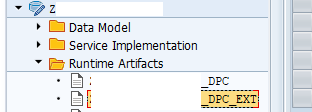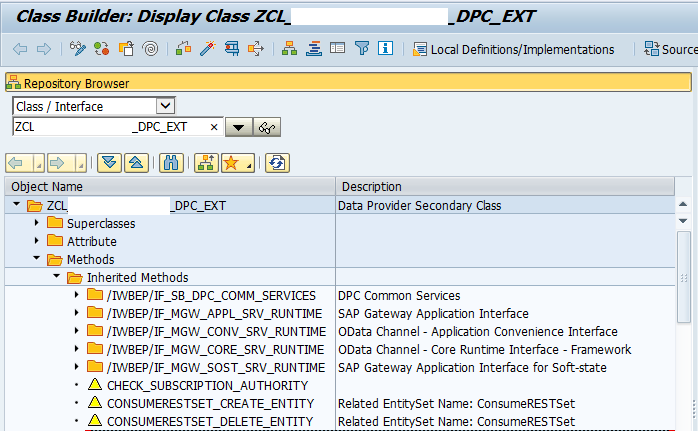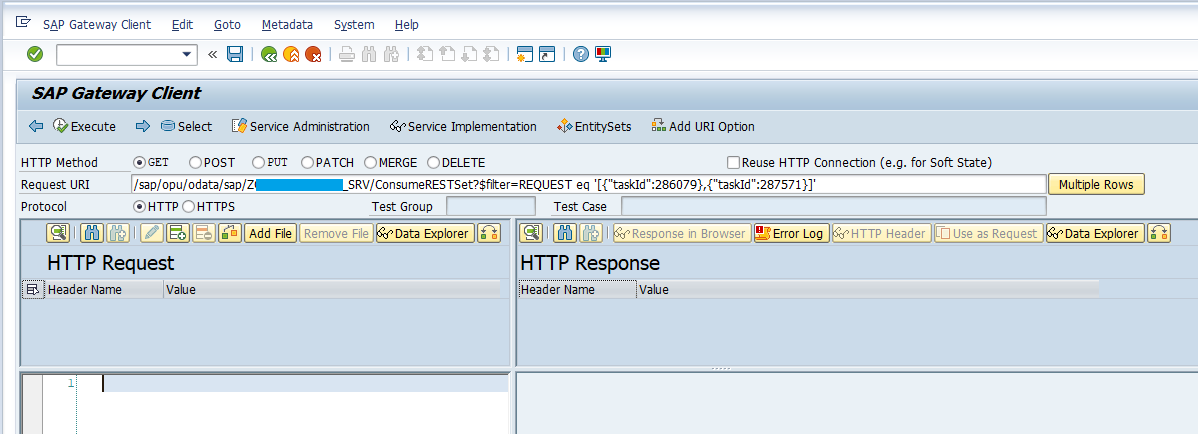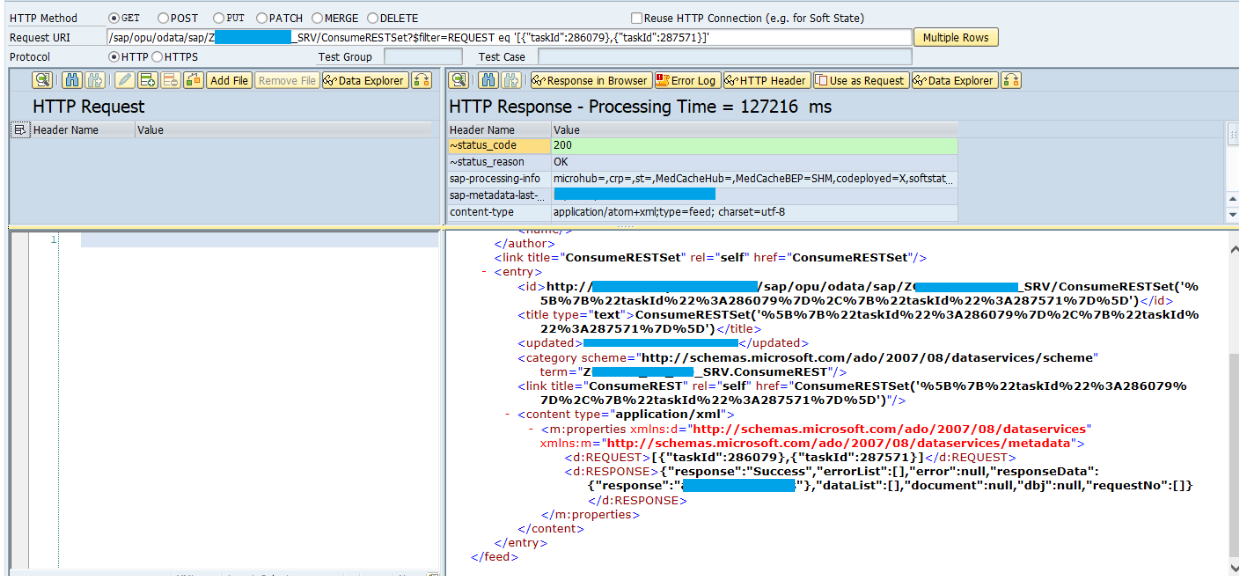
- SAP Community
- Products and Technology
- Technology
- Technology Blogs by Members
- SAP oData Service [GET]: Consume REST Service
Technology Blogs by Members
Explore a vibrant mix of technical expertise, industry insights, and tech buzz in member blogs covering SAP products, technology, and events. Get in the mix!
Turn on suggestions
Auto-suggest helps you quickly narrow down your search results by suggesting possible matches as you type.
Showing results for
dilipkkp2412
Contributor
Options
- Subscribe to RSS Feed
- Mark as New
- Mark as Read
- Bookmark
- Subscribe
- Printer Friendly Page
- Report Inappropriate Content
04-15-2018
8:19 AM
Overview
- In this blog, we try to consume a REST-Services in an OData-Service.
- Here we use GET operation of OData-Service
- and while consuming the REST-Service, we use HTTP-Method as POST to send request message and in acknowledgement REST-Service provides response which will be mapped to OData-Service's structure.
- This blogs is a business case example of parent blog:
Business Scenario:
- In a fiori-app, where data need to be accessed from a non-sap system.
- This non-sap system has a REST-Service technique for data exchange to out-side world.
- So, in fiori-App, we need an oData-Service which can consume/talk to non-sap's REST-Service for data Exchange.
- Note: Here we can consume REST-Services directly in fiori-App, but we recommend to access this via oData-Service, due to following reasons:
- The Cross-domain issue in JavaScript codes while accessing REST-Services when we deploy fiori-App in Fiori-Server.
REST Service Details:
- This REST-Service of non-sap system is a medium for data exchange between SAP-FioriApp and non-sap system
- REST (REpresenational State Transfer) is an architectural style that uses simple and lightweight mechanism for inter-machine communication.
- In this blog's example, this REST-Service has following components for data-exchange:
- EndPoint-URL:
- This consists of http(s), host, port and RestProjectPath of Non-SAP system
- For Example:
- Access-credentials:
- user-id and password which is required to access this REST service
- Request-Message:
- This is the input format which respective REST-Service understands, for which it runs its program logic and returns data accordingly.
- Here, below is the JASON input format:
[
{
"taskId":286079
},
{
"taskId":287571
}
]
- Response-Message:
- This is the output message format which we receive from REST-Service in acknowledgement.
- Here, output format is like:
{
"response":"Success",
"responseData":{
"response":"Posted successfully"
},
"error":null,
"errorList":[]
}
- EndPoint-URL:
- REST Services are working with ‘Resources’ instead of ‘Operations’
Steps to create oData Service [with GET_ENTITYSET]:
- To Consume above REST-Service, we implement oData-Service in following manner:
- Creation of an EntitySet which will have two Property:
- REQUEST
- To send JSON-Input in given REST-Service format
- RESPONSE
- To receive JSON-output from REST-Service.
- REQUEST
- Re-Definition of method 'GET_ENTITYSET' of respective Enity, where we write ABAP-Code to consume REST-Service.
- Creation of an EntitySet which will have two Property:
- Following detailed Steps can be followed for same:
[1] Create an EntityType and EntitySet
- To Create an OData-Serivice, go-to SAP-Firoi-Server t-code 'SEGW'
- Right click on Project's folder 'Entity Types' to create an Entity

- with Name 'ConsumeREST' with EntitySet name 'ConsumeRESTSet'

- Create two properties (REQUEST and RESPONSE) and make REQUEST as key.

- Save and 'Generate Runtime object’ by clicking circle icon (red/white) with project selection.
- Thus meta-structure for EntitySet gets created.
[2] Redefine method 'ConsumeRESTSet_GET_ENTITYSET'
- Next we need to re-define method 'GET_ENTITYSET' where abap-code will be written to consume REST service. This method will have following functionalities:
- Get input from property 'REQUEST' of ODataService's EntitySet 'ConsumeRESTSet'
- Consume/trigger REST-Service with this input
- In acknowledgement, REST-Service provide response, extract it and map it to oDataService's EntitySet 'ConsumeRESTSet' in property 'RESPONSE'
- To re-define same, go to Odata-Service project's folder 'Runtiime Artifacts' -> select 'DPC_EXT' class -> double click on it to go to abap runtime workbench

- Below is '_DPC_EXT' class, where we re-define 'GET_ENTITYSET'
- Go to folder '_DPC_EXT' -> folder 'Methods' -> folder 'Inherited Methods'

- select method 'ConsumeRESTSet_GET_ENTITYSET' -> right click -> select 'Redefine'

- Once method redefined, it get listed inside folder 'Methods/Redefinitions'
- and we write abap-code iside this method to do following tasks:
- To read input from property 'REQUEST' of ODataService's EntitySet 'ConsumeRESTSet'
- Call REST-Service by sending input and using its endpoint url
- In acknowledgement, REST-Service provide response,
- extract it and map it to oDataService's EntitySet 'ConsumeRESTSet' in property 'RESPONSE'
- Please note:
- We can not do it in redefinition of GET_ENTITY, because get_filter does not accessible inside it.
- Below is the screen of method 'ConsumeRESTSet_GET_ENTITYSET'

- And ABAP code written inside method 'ConsumeRESTSet_GET_ENTITYSET' is as follows:
method CONSUMERESTSET_GET_ENTITYSET.
DATA: lt_filters TYPE /iwbep/t_mgw_select_option,
ls_filter TYPE /iwbep/s_mgw_select_option,
ls_so TYPE /iwbep/s_cod_select_option,
LS_CONSUMERESTSET TYPE ZCL_ZTEST_ODATA_MPC=>TS_CONSUMEREST.
DATA: lv_RestSrvUrl TYPE STRING, "Var for Http REST Service Url
lv_HTTP_CLIENT TYPE REF TO IF_HTTP_CLIENT, "Var for Rest Http Client
LV_REQUEST TYPE STRING,
LV_RESPONSE TYPE STRING.
* Initiating filter to Read input from EnitySet of ODataService
lt_filters = io_tech_request_context->get_filter( )->get_filter_select_options( ).
* Extract input from Property 'REQUEST' of EntitySet 'CONSUMERESTSet'
Clear ls_filter.
READ TABLE lt_filters WITH TABLE KEY property = 'REQUEST' INTO ls_filter.
IF sy-subrc EQ 0.
READ TABLE ls_filter-select_options INTO ls_so index 1.
IF sy-subrc EQ 0.
LV_REQUEST = ls_so-low.
ENDIF.
ENDIF.
* REST Service URL
lv_RestSrvUrl = 'http://<ServiceIP>:<Port>/<REST_Service_Path>'.
*Steps to Call REST Service ===================================
*STEP-1 : CREATE HTTP CLIENT
CALL METHOD CL_HTTP_CLIENT=>CREATE_BY_URL
EXPORTING
URL = lv_RestSrvUrl
IMPORTING
CLIENT = lv_HTTP_CLIENT
EXCEPTIONS
ARGUMENT_NOT_FOUND = 1
PLUGIN_NOT_ACTIVE = 2
INTERNAL_ERROR = 3
OTHERS = 4
.
*STEP-2 : AUTHENTICATE HTTP CLIENT
CALL METHOD LV_HTTP_CLIENT->AUTHENTICATE
EXPORTING
USERNAME = 'Service_user-id'
PASSWORD = 'Service_password'.
*STEP-3 : Set headers for REST Service Request Call
CALL METHOD lv_HTTP_CLIENT->REQUEST->SET_HEADER_FIELD
EXPORTING NAME = '~request_method'
VALUE = 'POST'.
CALL METHOD lv_HTTP_CLIENT->REQUEST->SET_HEADER_FIELD
EXPORTING NAME = 'Content-Type'
VALUE = 'application/json; charset=utf-8'.
CALL METHOD lv_HTTP_CLIENT->REQUEST->SET_HEADER_FIELD
EXPORTING NAME = 'Accept'
VALUE = 'application/json, text/html'.
* STEP-3.1 : Attach Request Message
CALL METHOD LV_HTTP_CLIENT->REQUEST->SET_CDATA
EXPORTING DATA = LV_REQUEST
OFFSET = 0.
*STEP-4 : SEND HTTP REQUEST
CALL METHOD lv_HTTP_CLIENT->SEND
EXCEPTIONS
HTTP_COMMUNICATION_FAILURE = 1
HTTP_INVALID_STATE = 2.
*STEP-5 : GET HTTP RESPONSE
CALL METHOD lv_HTTP_CLIENT->RECEIVE
EXCEPTIONS
HTTP_COMMUNICATION_FAILURE = 1
HTTP_INVALID_STATE = 2
HTTP_PROCESSING_FAILED = 3.
*STEP-6 : Extract Rest-Service-Response
CLEAR LV_RESPONSE.
LV_RESPONSE = lv_HTTP_CLIENT->response->get_cdata( ).
*STEP-7 : Appending Rest-Service-Response to EntitySet of ODataService
CLEAR LS_CONSUMERESTSET.
LS_CONSUMERESTSET-REQUEST = LV_REQUEST. "Append Sent Request
LS_CONSUMERESTSET-RESPONSE = LV_RESPONSE. "Append Receievd Response
APPEND LS_CONSUMERESTSET TO ET_ENTITYSET.
CLEAR LS_CONSUMERESTSET.
endmethod.
- Save and activate this method.
[3] Testing OData-Service which consumes REST-Service
- Once above implementation gets completed, we can begin testing of service.
- Note: before testing make sure, odataService is already registered, for same you can refer below blog of mine:
- For testing in Fiori-server, go to t-code '/n/iwfnd/gw_client' and below oDataService uri will be used to invoke REST service via oData.
- here we are referring EntitySet 'ConsumeRESTSet'
- and in property 'REQUEST' we are passing JSON-Format input string which need to be send to REST-Service while calling
- This JSON-Input-String is REST-Service's input message format.
/sap/opu/odata/sap/ZTEST_ODATA_SRV/ConsumeRESTSet?$filter=REQUEST eq '[{"taskId":286079},{"taskId":287571}]'
- select Protocol 'HTTP'
- select HTTP Method 'GET', here please note we are passing input in uri

- Execute press 'F8' -> and in acknowledgement, we received REST-Service's output in Property 'RESPONSE'.
- for reference Here 'REQUEST' property has same data which we supplied as an input.

[4] Debugging OData-Service which consumes REST-Service
- Lets debug method 'ConsumeRESTSet_GET_ENTITYSET' to understand data flow.
- Set external breakpoints

- Execute/trigger oData Service from t-code '/n/iwfnd/gw_client'

- Debugger enters in method, see first we have extracted input from property 'REQUEST' of ODataService's EntitySet 'ConsumeRESTSet' into variable LV_REQUEST

- Next debugger stops post calling REST-Service, where we can understand with help of variable data 'LV_RESPONSE' which has extracted output from REST-Service acknowledgement

- The REST-Service's output present in variable 'LV_RESPONSE'. is been mapped/populated to oData-Service' EntitySet 'ConsumeRESTSet' with help of structure 'ET_ENTITYSET' as shown in below screen

- Thus we have understood how data is flowing from oDataService call to REST-Service call.
- SAP Managed Tags:
- SAP Fiori
9 Comments
You must be a registered user to add a comment. If you've already registered, sign in. Otherwise, register and sign in.
Labels in this area
-
"automatische backups"
1 -
"regelmäßige sicherung"
1 -
505 Technology Updates 53
1 -
ABAP
14 -
ABAP API
1 -
ABAP CDS Views
2 -
ABAP CDS Views - BW Extraction
1 -
ABAP CDS Views - CDC (Change Data Capture)
1 -
ABAP class
2 -
ABAP Cloud
2 -
ABAP Development
5 -
ABAP in Eclipse
1 -
ABAP Platform Trial
1 -
ABAP Programming
2 -
abap technical
1 -
absl
1 -
access data from SAP Datasphere directly from Snowflake
1 -
Access data from SAP datasphere to Qliksense
1 -
Accrual
1 -
action
1 -
adapter modules
1 -
Addon
1 -
Adobe Document Services
1 -
ADS
1 -
ADS Config
1 -
ADS with ABAP
1 -
ADS with Java
1 -
ADT
2 -
Advance Shipping and Receiving
1 -
Advanced Event Mesh
3 -
AEM
1 -
AI
7 -
AI Launchpad
1 -
AI Projects
1 -
AIML
9 -
Alert in Sap analytical cloud
1 -
Amazon S3
1 -
Analytical Dataset
1 -
Analytical Model
1 -
Analytics
1 -
Analyze Workload Data
1 -
annotations
1 -
API
1 -
API and Integration
3 -
API Call
2 -
Application Architecture
1 -
Application Development
5 -
Application Development for SAP HANA Cloud
3 -
Applications and Business Processes (AP)
1 -
Artificial Intelligence
1 -
Artificial Intelligence (AI)
4 -
Artificial Intelligence (AI) 1 Business Trends 363 Business Trends 8 Digital Transformation with Cloud ERP (DT) 1 Event Information 462 Event Information 15 Expert Insights 114 Expert Insights 76 Life at SAP 418 Life at SAP 1 Product Updates 4
1 -
Artificial Intelligence (AI) blockchain Data & Analytics
1 -
Artificial Intelligence (AI) blockchain Data & Analytics Intelligent Enterprise
1 -
Artificial Intelligence (AI) blockchain Data & Analytics Intelligent Enterprise Oil Gas IoT Exploration Production
1 -
Artificial Intelligence (AI) blockchain Data & Analytics Intelligent Enterprise sustainability responsibility esg social compliance cybersecurity risk
1 -
ASE
1 -
ASR
2 -
ASUG
1 -
Attachments
1 -
Authorisations
1 -
Automating Processes
1 -
Automation
1 -
aws
2 -
Azure
1 -
Azure AI Studio
1 -
B2B Integration
1 -
Backorder Processing
1 -
Backup
1 -
Backup and Recovery
1 -
Backup schedule
1 -
BADI_MATERIAL_CHECK error message
1 -
Bank
1 -
BAS
1 -
basis
2 -
Basis Monitoring & Tcodes with Key notes
2 -
Batch Management
1 -
BDC
1 -
Best Practice
1 -
bitcoin
1 -
Blockchain
3 -
BOP in aATP
1 -
BOP Segments
1 -
BOP Strategies
1 -
BOP Variant
1 -
BPC
1 -
BPC LIVE
1 -
BTP
11 -
BTP Destination
2 -
Business AI
1 -
Business and IT Integration
1 -
Business application stu
1 -
Business Architecture
1 -
Business Communication Services
1 -
Business Continuity
1 -
Business Data Fabric
3 -
Business Partner
12 -
Business Partner Master Data
10 -
Business Technology Platform
2 -
Business Trends
1 -
CA
1 -
calculation view
1 -
CAP
3 -
Capgemini
1 -
CAPM
1 -
Catalyst for Efficiency: Revolutionizing SAP Integration Suite with Artificial Intelligence (AI) and
1 -
CCMS
2 -
CDQ
12 -
CDS
2 -
Cental Finance
1 -
Certificates
1 -
CFL
1 -
Change Management
1 -
chatbot
1 -
chatgpt
3 -
CL_SALV_TABLE
2 -
Class Runner
1 -
Classrunner
1 -
Cloud ALM Monitoring
1 -
Cloud ALM Operations
1 -
cloud connector
1 -
Cloud Extensibility
1 -
Cloud Foundry
3 -
Cloud Integration
6 -
Cloud Platform Integration
2 -
cloudalm
1 -
communication
1 -
Compensation Information Management
1 -
Compensation Management
1 -
Compliance
1 -
Compound Employee API
1 -
Configuration
1 -
Connectors
1 -
Consolidation Extension for SAP Analytics Cloud
1 -
Controller-Service-Repository pattern
1 -
Conversion
1 -
Cosine similarity
1 -
cryptocurrency
1 -
CSI
1 -
ctms
1 -
Custom chatbot
3 -
Custom Destination Service
1 -
custom fields
1 -
Customer Experience
1 -
Customer Journey
1 -
Customizing
1 -
Cyber Security
2 -
Data
1 -
Data & Analytics
1 -
Data Aging
1 -
Data Analytics
2 -
Data and Analytics (DA)
1 -
Data Archiving
1 -
Data Back-up
1 -
Data Governance
5 -
Data Integration
2 -
Data Quality
12 -
Data Quality Management
12 -
Data Synchronization
1 -
data transfer
1 -
Data Unleashed
1 -
Data Value
8 -
database tables
1 -
Datasphere
2 -
datenbanksicherung
1 -
dba cockpit
1 -
dbacockpit
1 -
Debugging
2 -
Delimiting Pay Components
1 -
Delta Integrations
1 -
Destination
3 -
Destination Service
1 -
Developer extensibility
1 -
Developing with SAP Integration Suite
1 -
Devops
1 -
digital transformation
1 -
Documentation
1 -
Dot Product
1 -
DQM
1 -
dump database
1 -
dump transaction
1 -
e-Invoice
1 -
E4H Conversion
1 -
Eclipse ADT ABAP Development Tools
2 -
edoc
1 -
edocument
1 -
ELA
1 -
Embedded Consolidation
1 -
Embedding
1 -
Embeddings
1 -
Employee Central
1 -
Employee Central Payroll
1 -
Employee Central Time Off
1 -
Employee Information
1 -
Employee Rehires
1 -
Enable Now
1 -
Enable now manager
1 -
endpoint
1 -
Enhancement Request
1 -
Enterprise Architecture
1 -
ETL Business Analytics with SAP Signavio
1 -
Euclidean distance
1 -
Event Dates
1 -
Event Driven Architecture
1 -
Event Mesh
2 -
Event Reason
1 -
EventBasedIntegration
1 -
EWM
1 -
EWM Outbound configuration
1 -
EWM-TM-Integration
1 -
Existing Event Changes
1 -
Expand
1 -
Expert
2 -
Expert Insights
1 -
Fiori
14 -
Fiori Elements
2 -
Fiori SAPUI5
12 -
Flask
1 -
Full Stack
8 -
Funds Management
1 -
General
1 -
Generative AI
1 -
Getting Started
1 -
GitHub
8 -
Grants Management
1 -
groovy
1 -
GTP
1 -
HANA
5 -
HANA Cloud
2 -
Hana Cloud Database Integration
2 -
HANA DB
1 -
HANA XS Advanced
1 -
Historical Events
1 -
home labs
1 -
HowTo
1 -
HR Data Management
1 -
html5
8 -
Identity cards validation
1 -
idm
1 -
Implementation
1 -
input parameter
1 -
instant payments
1 -
Integration
3 -
Integration Advisor
1 -
Integration Architecture
1 -
Integration Center
1 -
Integration Suite
1 -
intelligent enterprise
1 -
Java
1 -
job
1 -
Job Information Changes
1 -
Job-Related Events
1 -
Job_Event_Information
1 -
joule
4 -
Journal Entries
1 -
Just Ask
1 -
Kerberos for ABAP
8 -
Kerberos for JAVA
8 -
Launch Wizard
1 -
Learning Content
2 -
Life at SAP
1 -
lightning
1 -
Linear Regression SAP HANA Cloud
1 -
local tax regulations
1 -
LP
1 -
Machine Learning
2 -
Marketing
1 -
Master Data
3 -
Master Data Management
14 -
Maxdb
2 -
MDG
1 -
MDGM
1 -
MDM
1 -
Message box.
1 -
Messages on RF Device
1 -
Microservices Architecture
1 -
Microsoft Universal Print
1 -
Middleware Solutions
1 -
Migration
5 -
ML Model Development
1 -
Modeling in SAP HANA Cloud
8 -
Monitoring
3 -
MTA
1 -
Multi-Record Scenarios
1 -
Multiple Event Triggers
1 -
Neo
1 -
New Event Creation
1 -
New Feature
1 -
Newcomer
1 -
NodeJS
2 -
ODATA
2 -
OData APIs
1 -
odatav2
1 -
ODATAV4
1 -
ODBC
1 -
ODBC Connection
1 -
Onpremise
1 -
open source
2 -
OpenAI API
1 -
Oracle
1 -
PaPM
1 -
PaPM Dynamic Data Copy through Writer function
1 -
PaPM Remote Call
1 -
PAS-C01
1 -
Pay Component Management
1 -
PGP
1 -
Pickle
1 -
PLANNING ARCHITECTURE
1 -
Popup in Sap analytical cloud
1 -
PostgrSQL
1 -
POSTMAN
1 -
Process Automation
2 -
Product Updates
4 -
PSM
1 -
Public Cloud
1 -
Python
4 -
Qlik
1 -
Qualtrics
1 -
RAP
3 -
RAP BO
2 -
Record Deletion
1 -
Recovery
1 -
recurring payments
1 -
redeply
1 -
Release
1 -
Remote Consumption Model
1 -
Replication Flows
1 -
Research
1 -
Resilience
1 -
REST
1 -
REST API
1 -
Retagging Required
1 -
Risk
1 -
Rolling Kernel Switch
1 -
route
1 -
rules
1 -
S4 HANA
1 -
S4 HANA Cloud
1 -
S4 HANA On-Premise
1 -
S4HANA
3 -
S4HANA_OP_2023
2 -
SAC
10 -
SAC PLANNING
9 -
SAP
4 -
SAP ABAP
1 -
SAP Advanced Event Mesh
1 -
SAP AI Core
8 -
SAP AI Launchpad
8 -
SAP Analytic Cloud Compass
1 -
Sap Analytical Cloud
1 -
SAP Analytics Cloud
4 -
SAP Analytics Cloud for Consolidation
2 -
SAP Analytics Cloud Story
1 -
SAP analytics clouds
1 -
SAP BAS
1 -
SAP Basis
6 -
SAP BODS
1 -
SAP BODS certification.
1 -
SAP BTP
20 -
SAP BTP Build Work Zone
2 -
SAP BTP Cloud Foundry
5 -
SAP BTP Costing
1 -
SAP BTP CTMS
1 -
SAP BTP Innovation
1 -
SAP BTP Migration Tool
1 -
SAP BTP SDK IOS
1 -
SAP Build
11 -
SAP Build App
1 -
SAP Build apps
1 -
SAP Build CodeJam
1 -
SAP Build Process Automation
3 -
SAP Build work zone
10 -
SAP Business Objects Platform
1 -
SAP Business Technology
2 -
SAP Business Technology Platform (XP)
1 -
sap bw
1 -
SAP CAP
2 -
SAP CDC
1 -
SAP CDP
1 -
SAP Certification
1 -
SAP Cloud ALM
4 -
SAP Cloud Application Programming Model
1 -
SAP Cloud Integration for Data Services
1 -
SAP cloud platform
8 -
SAP Companion
1 -
SAP CPI
3 -
SAP CPI (Cloud Platform Integration)
2 -
SAP CPI Discover tab
1 -
sap credential store
1 -
SAP Customer Data Cloud
1 -
SAP Customer Data Platform
1 -
SAP Data Intelligence
1 -
SAP Data Migration in Retail Industry
1 -
SAP Data Services
1 -
SAP DATABASE
1 -
SAP Dataspher to Non SAP BI tools
1 -
SAP Datasphere
9 -
SAP DRC
1 -
SAP EWM
1 -
SAP Fiori
2 -
SAP Fiori App Embedding
1 -
Sap Fiori Extension Project Using BAS
1 -
SAP GRC
1 -
SAP HANA
1 -
SAP HCM (Human Capital Management)
1 -
SAP HR Solutions
1 -
SAP IDM
1 -
SAP Integration Suite
9 -
SAP Integrations
4 -
SAP iRPA
2 -
SAP Learning Class
1 -
SAP Learning Hub
1 -
SAP Odata
2 -
SAP on Azure
1 -
SAP PartnerEdge
1 -
sap partners
1 -
SAP Password Reset
1 -
SAP PO Migration
1 -
SAP Prepackaged Content
1 -
SAP Process Automation
2 -
SAP Process Integration
2 -
SAP Process Orchestration
1 -
SAP S4HANA
2 -
SAP S4HANA Cloud
1 -
SAP S4HANA Cloud for Finance
1 -
SAP S4HANA Cloud private edition
1 -
SAP Sandbox
1 -
SAP STMS
1 -
SAP SuccessFactors
2 -
SAP SuccessFactors HXM Core
1 -
SAP Time
1 -
SAP TM
2 -
SAP Trading Partner Management
1 -
SAP UI5
1 -
SAP Upgrade
1 -
SAP-GUI
8 -
SAP_COM_0276
1 -
SAPBTP
1 -
SAPCPI
1 -
SAPEWM
1 -
sapmentors
1 -
saponaws
2 -
SAPUI5
4 -
schedule
1 -
Secure Login Client Setup
8 -
security
9 -
Selenium Testing
1 -
SEN
1 -
SEN Manager
1 -
service
1 -
SET_CELL_TYPE
1 -
SET_CELL_TYPE_COLUMN
1 -
SFTP scenario
2 -
Simplex
1 -
Single Sign On
8 -
Singlesource
1 -
SKLearn
1 -
soap
1 -
Software Development
1 -
SOLMAN
1 -
solman 7.2
2 -
Solution Manager
3 -
sp_dumpdb
1 -
sp_dumptrans
1 -
SQL
1 -
sql script
1 -
SSL
8 -
SSO
8 -
Substring function
1 -
SuccessFactors
1 -
SuccessFactors Time Tracking
1 -
Sybase
1 -
system copy method
1 -
System owner
1 -
Table splitting
1 -
Tax Integration
1 -
Technical article
1 -
Technical articles
1 -
Technology Updates
1 -
Technology Updates
1 -
Technology_Updates
1 -
Threats
1 -
Time Collectors
1 -
Time Off
2 -
Tips and tricks
2 -
Tools
1 -
Trainings & Certifications
1 -
Transport in SAP BODS
1 -
Transport Management
1 -
TypeScript
2 -
unbind
1 -
Unified Customer Profile
1 -
UPB
1 -
Use of Parameters for Data Copy in PaPM
1 -
User Unlock
1 -
VA02
1 -
Validations
1 -
Vector Database
1 -
Vector Engine
1 -
Visual Studio Code
1 -
VSCode
1 -
Web SDK
1 -
work zone
1 -
workload
1 -
xsa
1 -
XSA Refresh
1
- « Previous
- Next »
Related Content
- SOAMANAGER - Field Cardinality - Min Occurence - WSDL in Technology Q&A
- 体验更丝滑!SAP 分析云 2024.07 版功能更新 in Technology Blogs by SAP
- SAP HANA Cloud Vector Engine: Quick FAQ Reference in Technology Blogs by SAP
- Receive a notification when your storage quota of SAP Cloud Transport Management passes 85% in Technology Blogs by SAP
- Annotation in SEGW in Technology Q&A
Top kudoed authors
| User | Count |
|---|---|
| 11 | |
| 9 | |
| 7 | |
| 6 | |
| 4 | |
| 4 | |
| 3 | |
| 3 | |
| 3 | |
| 3 |